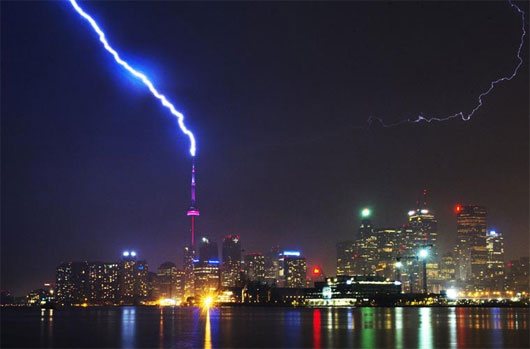Lightning protection with laser
A team of researchers from the University of Arizona and Central Florida (USA) believes that it is possible to completely change the direction of lightning 'path' by using specially designed laser beams , instead of using The traditional way is to use lightning rods to 'safely' transport medium lightning and about 1 billion Joule (J) of energy into the ground.
>>>Lightning disaster
ExtremeTech said that, according to the general principle, lightning will choose the path with the least impedance to go to the ground. A large metal rod, with wires leading into the ground, has less resistance than air (which has a very high charge), so that the lightning selects the metal bar to transmit electricity to the ground.

Scientists are studying laser beam direction changes - (Artwork: Rediff.com)
Meanwhile, lasers moving through the air will leave an ionized gas (also called plasma gas ), which contains little or no electrical charge with high electrical conductivity. And when light rays (in the case of lightning) pass through the space with this minimum capacitance, their energy will also theoretically change.
However, the problem here is that the laser cannot travel long distances in the air without the 'defocus' .
Therefore, to create a long enough plasma column / gas channel - from the ground to the top of the building, the researchers created a method to beam the 'high energy' laser beams into gas.
This method is named 'external optical hopper' (externally reflex optical filament) , and is generated by two laser beams of different energy intensity.
Maik Scheller, a researcher at Arizona State University, likens this method to two planes flying together, in which a small fighter is equipped with a large fuel tank.
Specifically, the first laser with low energy will 'rip' the sky, while the second laser at a higher energy level will resupply (the energy) the first beam so that it does not get lost 'target ' , or to be precise in this case is the lightning reception point.
Although this method is currently only successful in realistic plasma column testing of 2.1 m (about 7 feet), the research team believes that they will soon reach 49.5 m (165 feet), according to ExtremeTech. .
- Some measures to prevent lightning
- Lightning bolt
- How is the aircraft protected against lightning?
- Why does lightning do not affect aircraft while flying?
- How to not be struck by thunderstorms?
- Find solutions to help the aircraft completely immune to thunder
- 10 disastrous misconceptions about lightning
- Lightning protection rules for people
- Glasses against laser
- Missile Laser - Solution for air defense
- If lightning hits the plane ...
- Lightning disaster
 Is the magnetic North Pole shift dangerous to humanity?
Is the magnetic North Pole shift dangerous to humanity? Washington legalizes the recycling of human bodies into fertilizer
Washington legalizes the recycling of human bodies into fertilizer Lightning stone - the mysterious guest
Lightning stone - the mysterious guest Stunned by the mysterious sunset, strange appearance
Stunned by the mysterious sunset, strange appearance